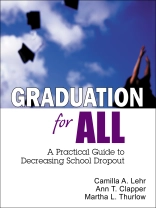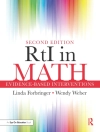‘I found this book well organized and very user friendly. It outlines from beginning to end a process for taking on the issue of school dropout.’
-Geralynn Olvey, Program Specialist
Mountain Plains Regional Resource Center, CO
‘The authors supply insight into areas of early intervention, truancy indicators, and the importance of students feeling that they belong to their school and of their own engagement, whether it is by academics, the arts, or extracurricular activities.’
-Nancy Avolese, State Coordinator of Alternative Education
Pennsylvania Department of Education
Effective dropout prevention strategies for educators!
How can teachers and administrators steer students toward graduation and away from dropping out? What determining factors contribute to a student′s choice to drop out? Why is high school graduation such an important issue in society today? Effective prevention and intervention programs for the most vulnerable students are key to improving graduation rates. This practitioner-friendly resource offers guidelines for implementing dropout prevention strategies in the classroom, throughout the school, and at the district level.
Graduation for All melds research and practical tools to include both evidence-based intervention models and real-world examples. With the goal of producing an educated citizenry that contributes to the world in positive ways, the authors present tools and a plan for:
- Increasing graduation rates while decreasing dropout rates
- Meeting the standards set by the No Child Left Behind Act
- Pinpointing the most critical years for establishing a solid educational foundation
- Connecting with other groups to share ideas and prepare for change
The impact of increased graduation rates reaches beyond statistics-more graduates mean more individuals who are better prepared to meet the challenges of life after school, and better outcomes for youth, schools, and society in general.
Jadual kandungan
Preface
Acknowledgments
About the Authors
1. What This Book Is About
2. Getting Started
3. Putting the Problem of Dropout in Context: Looking at the Numbers
4. Understanding Why: Looking at the Reasons, the Process, and the Approach
5. Considering What to Work on: Contextual Influences and Indicators
6. Clarifying the Focus: Prevention and Intervention Programs
7. Putting the Pieces Together
8. Deciding What to Do
9. Maintaining Momentum
10. Evaluating Effectiveness
Resource A: Directory of Action Tools
Resource B: Glossary
Resource C: Related Links
Index
Mengenai Pengarang
Martha L. Thurlow, Ph.D., is Director of the National Center on Educational Outcomes in the Institute on Community Integration (University Center for Excellence in Developmental Disabilities) at the University of Minnesota. In this position, she addresses the implications of contemporary U.S. policy and practice for students with disabilities and English Language Learners, including national and statewide assessment policies and practices, standards-setting efforts, and graduation requirements. Dr. Thurlow has conducted research for the past 35 years in a variety of areas, including assessment and decision making, learning disabilities, early childhood education, dropout prevention, effective classroom instruction, and integration of students with disabilities in general education settings. She has published extensively on all of these topics, and also recently completed serving as co-Editor with Bob Algozzine of Exceptional Children, the research journal of the Council for Exceptional Children. Dr. Thurlow is a co-author of several books, including Testing Students with Disabilities, Improving Test Performance of Students with Disabilities, Alternate Assessments for Students with Disabilities, and Critical Issues in Special Education. Dr. Thurlow was one of the original developers of the dropout prevention program Check and Connect, which was empirically tested, and replicated in several settings. She is the author of numerous reports, journal articles and chapters on the topic of dropouts and dropout prevention, and also addresses the dropout problem within the current context of federal legislation, high stakes testing, and standards-based education.












